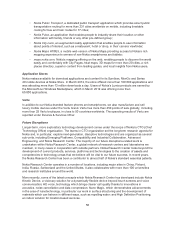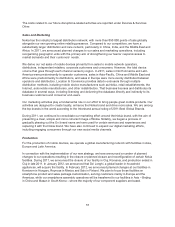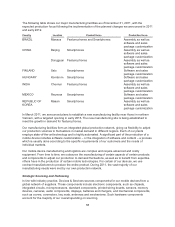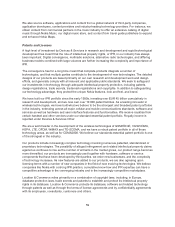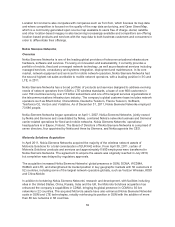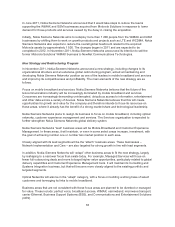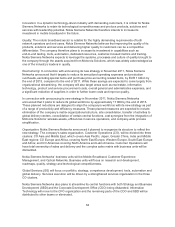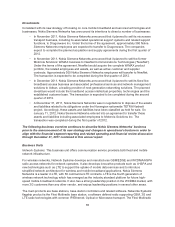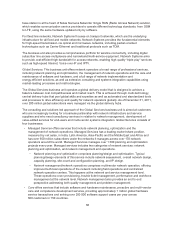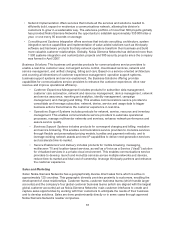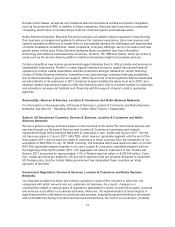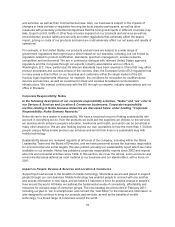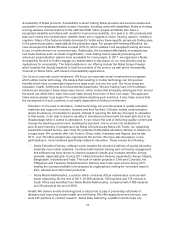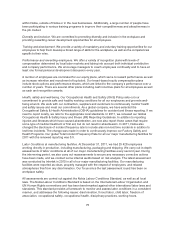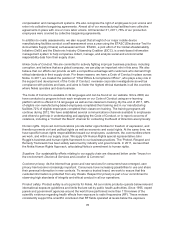Nokia 2011 Annual Report Download - page 68
Download and view the complete annual report
Please find page 68 of the 2011 Nokia annual report below. You can navigate through the pages in the report by either clicking on the pages listed below, or by using the keyword search tool below to find specific information within the annual report.base station is at the heart of Nokia Siemens Networks’ Single RAN (Radio Access Network) solution,
which enables communication service providers to operate different technology standards, from GSM
to LTE, using the same hardware updated only by software.
For fixed line networks, Network Systems focuses on transport networks, which are the underlying
infrastructure for all fixed and mobile networks. Network Systems provides the fundamental elements
for high-speed transmission via optical and microwave networks, including packet-oriented
technologies such as Carrier Ethernet and traditional protocols such as TDM.
The business unit also provides a comprehensive portfolio for wireline connectivity, including digital
subscriber line access multiplexers and narrowband/multi-service equipment. Network Systems aims
to provide cost-efficient high bandwidth for access networks, enabling high quality “triple play” services
such as high-speed Internet, Voice-over-IP and IPTV.
Global Services: This business unit offers network operators a broad range of professional services,
including network planning and optimization, the management of network operations and the care and
maintenance of software and hardware, and a full range of network implementation and
energy-efficient solutions, as well as extensive consulting and systems integration capabilities using
market-leading processes and methodologies.
The Global Services business unit operates a global delivery model that is designed to achieve a
balance between cost competitiveness and market reach. This is achieved through multi-technology,
central delivery hubs that pool global skills and expertise as well as automated and standardized tools
and processes to drive efficiency and quality for network operators globally. As of December 31, 2011,
over 200 million global subscribers were managed via the global delivery hubs.
The consulting and solutions led approach of the Global Services business unit is aimed at customers
who are increasingly looking for a business partnership with network infrastructure and service
suppliers and who need consultancy services in relation to network management, development of
value-added services for end-users and multi-vendor systems integration. Global Services consists of
four businesses:
•Managed Services offers services that include network planning, optimization and the
management of network operations. Managed Services has a leading market share position,
measured by net sales, in India, Latin America, Asia-Pacific and the Middle East and Africa and
has over 650 million subscribers under the networks it manages across over 170 network
operators around the world. Managed Services manages over 1 300 planning and optimization
projects every year. Managed services includes two categories of network services: network
planning and optimization, and network management and operations.
•Network planning and optimization comprises planning/design and optimization. Typical
planning/design elements of this service include network assessment, overall network design,
capacity planning, site-count and configuration planning, and IP design.
•Network management/network operations comprises multivendor network operation, offering
improved technical operations of the network including field operations and centralized
network operation centers. This happens at the network and service management level.
These operations cover provisioning, trouble ticket management, performance and workforce
management at the network level. Network management also provides an end to end
perspective addressing both quality management and problem management.
•Care offers services that include software and hardware maintenance, proactive and multi-vendor
care and competence development services, providing approximately 1 million global hardware
service transactions and solving over 200 000 software support cases per year across
600 customers in 150 countries.
66


